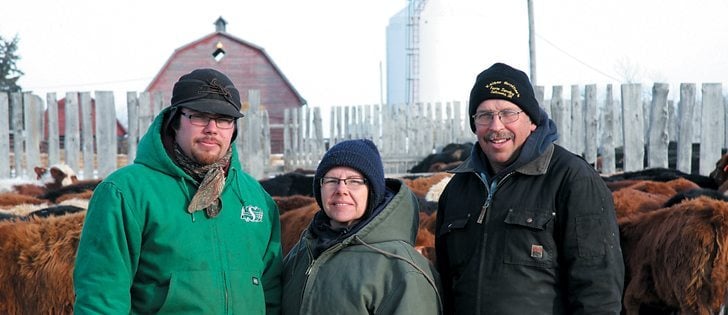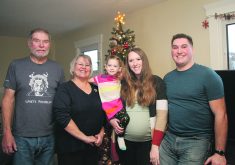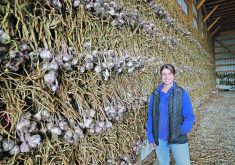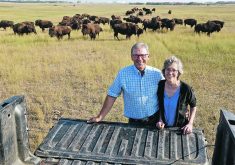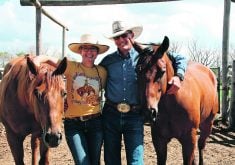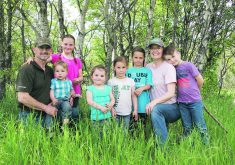WILLOWBROOK, Sask. — Levi Hull always knew he’d come back to the farm.
What he didn’t know was that he’d take his passion for the cattle industry into the political arena — at least not so early.
At 25, Hull has completed just more than a year of at least a two-year term as a director of the Saskatchewan Cattlemen’s Association.
He represents District 5, which includes a large chunk of east-central Saskatchewan.
He said the hardest part has been learning and keeping straight the many acronyms that the industry likes to use.
Read Also

Nutritious pork packed with vitamins, essential minerals
Recipes for pork
He also has to be away to attend meetings and events, but he has a great support system.
He operates the business with his mother and father, Debbie and Terry, who handle the 1,000 head when he’s gone. His girlfriend, Megan Magee, is a registered veterinary technologist at Animal Health Centre of Melville and regularly helps out at the farm.
Hull’s parents said they support their son’s decision to get involved.
He is the third generation on the land west of Yorkton. His two brothers, Leighton and Layne, are less involved in the operation.
He has a diploma in agricultural production from Olds College as well as a bachelor of applied science in agribusiness.
“I came back to the farm in 2011, and that fall I got some lease-to-own cows,” Hull said.
He added to the herd occasionally and last fall bought two quarters of land and more cows. He now owns 300 on his own.
The area around Willowbrook is largely grain land, and the family uses pasture, including community grazing near Melville and Theodore, both about 30 kilometres away but in opposite directions.
“We seed 1,200 acres of grain land, but everything gets turned back into a cow,” he said.
Hull has grown corn for the last four years. Some becomes silage and some is grazed. He is a big fan of corn grazing, as are the fat cows that re-cently munched their way through a stand.
In February, 165 cows had access to a couple of acres at a time.
“We aim for 250 cows days an acre. Last year we fed 350 deer, too.”
A recent major project was the reconstruction of the farm’s feedlot after extensive flooding in 2011.
“In 2012 we built the feedlot up, sloped the pens and built alleys,” Hull said. “We traditionally feed our own calves so it was a benefit to us to do the work.”
The feedlot was lifted three metres, gravel and clay trucked in and everything cleaned up.
Hull continues to work on feed bunks and other projects, but his work on the SCA board can sometimes limit him.
“I don’t think people realize the work that each rep puts in,” he said.
For example, he sat on the research and communication committees during his first year, as well as the committee that examined the transition of the former federal pastures.
He also tries to stay in touch with the producers he represents.
“I do hear from a few people. The community pasture issue was big,” he said.
One of his goals has been to make sure producers understand what their industry association is doing for them. He has invited producers who request check-off refunds to his district meeting.
“A few actually said, ‘this is the first time I’ve ever heard this,’ ” he said of his efforts to reach out.
It’s also important to him to keep on top of changes in the industry and to educate himself.
“If you’re just at home calving cows, doing the same things, you get caught in a rut,” he said.
Change is not unheard of on the Hull farm.
“We were more grain than cattle even 20 years ago,” he said.
However, the land was transitioned to hay and pasture and the cow herd expanded. He uses Angus cross cows, black Maine Anjou bulls on brockle-faced cows and horned Hereford bulls on solid red and black cows.
“A Red Baldie or a Black Baldie with black Maine is the best cross.”
They have also moved calving time from February and March to later in spring.
“Now everything calves the second week in May. We avoid snowstorms and we calve on grass in different groups,” he said.
The family also had to decide whether to go big or get out.
His parents wanted him to get out in the world, get his education and perhaps then come back.
“But the opportunity was starting to narrow,” Hull said. “It was either get in or get out so we went from 600 cows to 1,000. We used to feed 500 to 1,000 calves and we’ve doubled that.”
Corn grazing helps keep the workload manageable. The Hulls have swath grazed, but a year with heavy snow put an end to that.
Bush provides adequate shelter for cows on corn in this part of the province, but the Hulls water their animals rather than relying on snow.
“We just find they do better,” he said.
The feedlot’s capacity is 1,500 and will be expanding again this summer.
Hull will be up for re-election later this fall. He thinks he will stick with it, but of course voters will have their say and he will discuss workload with his parents.
“I think producers want to be engaged. They want to know what’s going on,” he said.
“It’s really opened my eyes. But you can’t do it without good help at home.”




